RBA model points to a house price slump of around 30%
A key finding from the RBA’s Saunders-Tulip model of the housing market that we have emphasised in judging the outlook for house prices is the extreme sensitivity of house prices to interest rates, where a permanent 100 basis point increase in the real cash rate reduces real house prices by an estimated one-third over the long term.
Using a modified version of the ST model, Coolabah Capital Investments has analysed the impact of temporary changes in interest rates on the housing market, focusing on current market pricing of a broad peak in the cash rate of 4.25% over 2023 followed by rate cuts in 2024 and 2025. This analysis suggests that this cycle in interest rates still has a significant effect in the short term, pointing to a large correction of about 30% in national home prices over the next four years (or circa 40% from late 2022 onwards). There is significant uncertainty around the model's forecasts, but the results suggest a large short-term correction is in store as the RBA takes back its emergency policy stimulus.
Over the past couple of years, CCI has used the ST model of the national housing market as an important guide to the outlook for house prices. This model was developed by Saunders and Tulip when they worked at the RBA and the RBA still uses it to assess the outlook for the housing market, even though it does not publish its forecasts for house prices in its Statement on Monetary Policy.
A key finding of the model is the pronounced sensitivity of house prices to interest rates, where a change in interest rates has an outsized effect on prices.
This outsized effect captures the inflexibility of the supply of housing, such that a boost to the demand for housing from lower interest rates is reflected more in house prices than the construction of more homes.
In the model, a permanent 100bp increase in in the real cash rate reduces real house prices over the long term by one-third.
In a steady low-inflation environment, this would translate to a similar reduction in nominal prices. This sensitivity is symmetric, in that a permanent 100bp rate cut increases real house prices by one-third over the long run, and is broadly linear, such that it can be scaled for a different change in the cash rate.

While the sensitivity of real house prices to a permanent increase in the cash rate is very important, we have used a modified version of the ST model to gauge the impact of temporary changes in monetary policy by focusing on market pricing of higher interest rates and eventual rate cuts on activity, prices and rents over the next four years.
In this analysis, the profile for interest rates was based on the current cash rate futures curve, extended by the bank bill futures curve, which has the cash rate peaking at about 4.25% over 2023 followed by rate cuts starting in 2024 and ending 2025 at 3.75%.
Also, key economic indicators were set to broadly follow official forecasts, where the unemployment rate, underlying inflation and household income were conditioned on the latest RBA forecasts, while the outlook for Australia’s population was based on Treasury budget estimates.
The modified model points to sharply lower home prices, higher rents and lower construction. Lower prices and housing activity mainly reflect the impact of temporarily higher interest rates. In contrast, the pick-up in rents mainly reflects the impact of stronger population growth following the re-opening of the international border.
-
Sharply lower national home prices.
After a 22% increase over last year, combined prices of houses and units are forecast to rise by 8% over 2022 before falling by 15% over 2023, 13% over 2024 and 11% over 2025, bringing the cumulative decline over four years to about 30% (or c40% from late 2022 onwards). The forecast rise of 8% over 2022 is likely to overestimate actual growth given national prices started to edge lower in April, but reflects a 4% rise in national home prices in the year to date, where higher interest rates affect prices with a slight lag;
-
Higher capital-city rents.
Rents broadly stabilised last year after the largest sustained fall since the 1930s during the pandemic, with the model forecasting a 1% increase over 2022, 2% over 2023, 3% over 2024, and 3% over 2025; and -
Sharply lower construction activity.
Real residential investment, which comprises the construction of new homes and renovations to existing homes, is expected to decline by 2% over 2022, 8% over 2023, and 6% over 2024, before broadly stabilising over 2025. These estimates may be too pessimistic for 2022 given a large backlog of work, although leading indicators of activity have slumped after government subsidies combined with low interest rates to bring forward an enormous amount of demand.
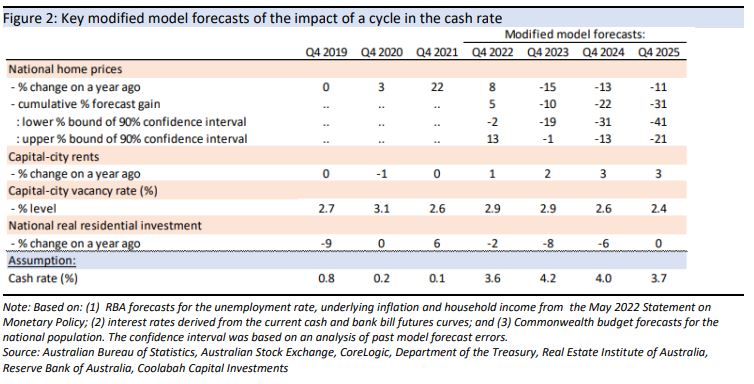
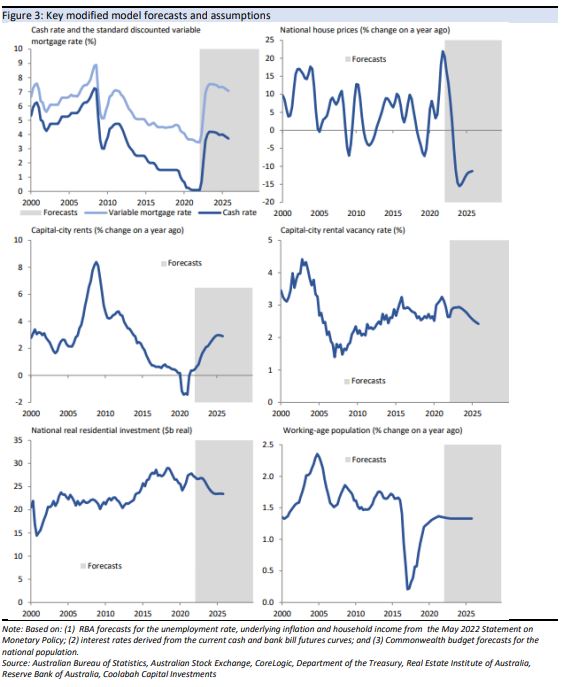
The ST model that has been modified for use in this analysis has likely been refined by the RBA since it was published a few years ago, but the broad rules of thumb for the impact of higher interest rates appear largely the same based on recent commentary from the RBA.
That is, the April Financial Stability Review noted that using the ST model “a 200bp increase in [real] interest rates from current levels would lower real house prices by around 15% over a two-year period relative to … [a] projection in the absence of an interest rate shock” (emphasis added).
Importantly, though, it should be stressed that there is significant uncertainty around the modified model’s results, firstly relating to how well the model has coped with the enormous economic and policy upheavals triggered by COVID and secondly relating to how COVID has magnified the inherent uncertainty around key model inputs.
The ructions caused by COVID have been unprecedented with the largest fiscal stimulus outside World War 2 and an unmatched monetary stimulus limiting the scarring from the severe recession of 2020 and promoting an exceptionally rapid economic recovery.
The extreme volatility of the economy has in turn greatly increased the inherent uncertainty around the forecasts for key inputs to the model, such as the cash rate, inflation and the population.
Uncertainty naturally increases over the forecast horizon, but this has been boosted by the fact that the modified model has been constrained, limiting feedback from the housing market to the broader economy and hence monetary policy, something that would be important for the estimates in late 2024 and 2025.
To highlight some of the uncertainty around the model results, we undertook a scenario analysis, where the current market pricing of a broadly year-long peak in the cash rate in 2023 – where the market factors in the start of rate cuts in 2024 – was varied by 100bp in both directions.
This type of sensitivity analysis yields significantly smaller near-term impacts than an assumed permanent change in the cash rate, but aligns with history, where the median duration of the peak in the cash rate since the mid-1980s is nine months.
In rounded terms, the results suggest that annual growth in home prices would be about 4pp weaker over 2023 (3pp higher) if the peak in the cash rate was 100bp temporarily higher (lower) than current market pricing. Growth in housing activity also varies, being 2pp worse (2pp better) with a higher (lower) peak in rates. Rents do not react much in either scenario.
These relatively modest near-term effects suggest that a correction in prices and activity is in store regardless of the exact peak in the cash rate mainly because of the RBA taking back the extraordinary emergency stimulus put in place during the pandemic.
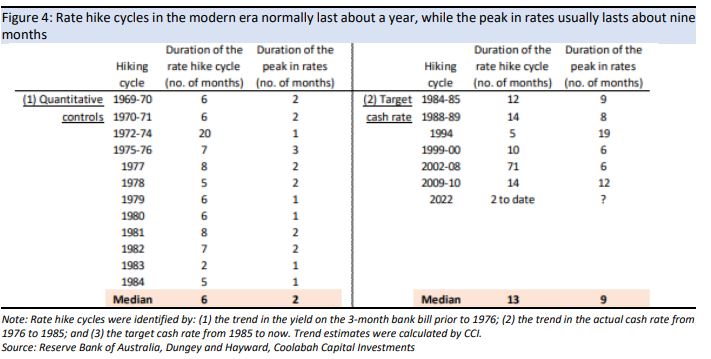
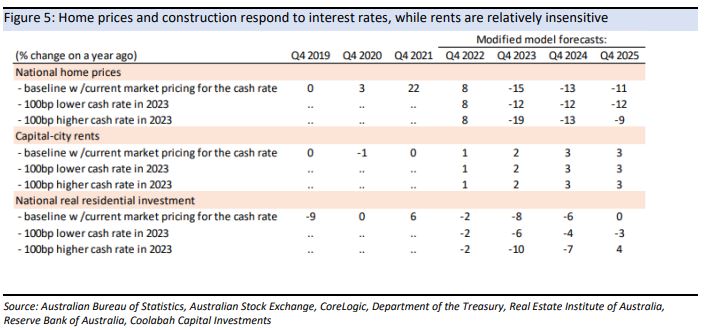
In assessing the risks around the outlook, the RBA has started raising rates to rein in the highest inflation in over a decade and a correction in the housing market will form a necessary part of how the RBA achieves its goal given housing has always been an important part of the transmission mechanism of monetary policy.
On current market pricing of the cash rate and mindful of the great uncertainty around the model results, home prices would eventually fall to their lowest level since 2015, although the eventual peak in interest rates remains uncertain given the underlying ex-COVID pace of inflation is unclear.
There is a meaningful risk that tight monetary policy will be required, particularly if higher consumer prices feed into higher inflation expectations, thereby entrenching high inflation, and a simple Taylor rule has long pointed to significantly higher rates in order to achieve a higher real cash rate.
That said, regardless of the exact peak in rates, history suggests that the RBA will likely start reversing course within a year of the peak, where eventual rate cuts should claw back some of the short-term correction in house prices.
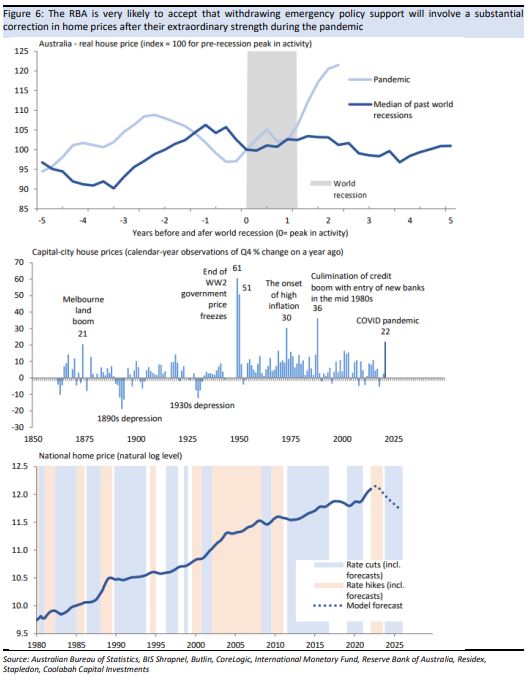
Access Coolabah's intellectual edge
With the biggest team in investment-grade Australian fixed-income and over $7 billion in FUM, Coolabah Capital Investments publishes unique insights and research on markets and macroeconomics from around the world overlaid leveraging its 14 analysts and 5 portfolio managers. Click the ‘CONTACT’ button below to get in touch.
3 topics

